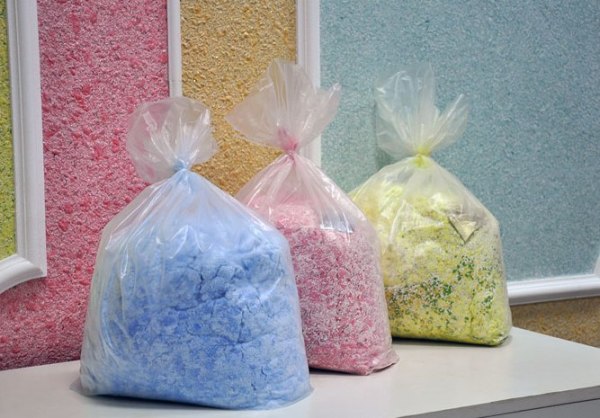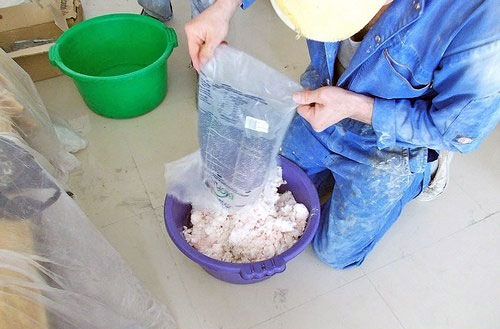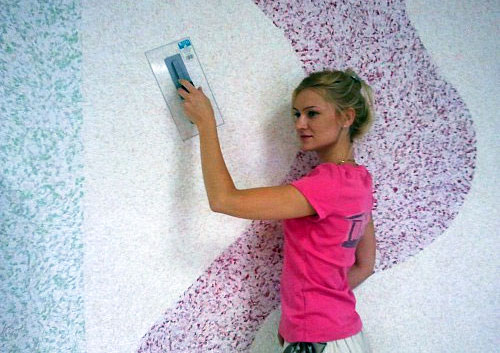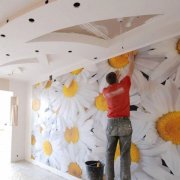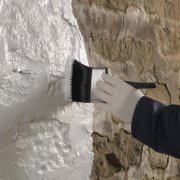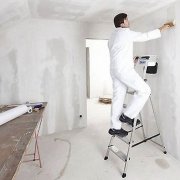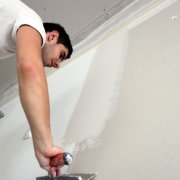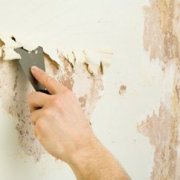Preparing walls for applying liquid wallpaper
How to apply liquid wallpaper on the walls? Such materials no longer represent the exclusive decoration of the room, but are its usual decoration, replacing the usual wallpaper. Many people know that after applying such a coating, the walls look elegant, but not everyone knows how to apply them correctly.
It happens that the owner of the apartment wants to put liquid wallpaper on the walls, but the cost of a professional's work is quite high, so the article will tell you in detail how to prepare the surfaces, and then apply the material on them with your own hands to save the family budget.
The content of the article
Coating features
Liquid wallpaper is a wall covering that is close to glass or decorative plasteror rather its variety.
The composition of the material includes:
- Cellulose.
- Silk fibers.
- Fillers that look like granules and special sparkles.
- Different colors dyes.
Wallpaper glue is used conventionally, which is used when deciding vinyl wallpaper or simple materials in rolls. The common between liquid wallpaper and decorative plaster is the same way they are applied to the walls, which makes it possible to apply such wallpaper everywhere, with much more advantages than roll materials.
These include:
- Easy and quick to apply to the surface of the wall, regardless of configuration and shape.
- Used for application.
- Combination of color and texture.
- Sticking liquid wallpaper on the wall gives the impression of wall decoration with the most expensive and high quality roll wallpaper. To the touch, they resemble vinyl wallpaper - soft and warm.
The lack of material is a higher price.
Tip: If the walls are covered with stucco with small or large grains, old paint, there are level differences and other defects, they will be visible. The presence on the surface of metal elements: hats from screws, parts of fittings, studs, pipes are not allowed, they will eventually come out, which will spoil the appearance of the coating.
How to prepare the walls
The use of a primer for liquid wallpaper will be the key to preserving their properties characteristic of this material:
- The color palette remains unchanged, regardless of the time of use.
- High strength characteristics.
- High rates of sound and heat insulation.
- Not much moisture absorption.
The technique of preparing the walls is selected depending on the properties of the surfaces for coating. This is due to the different interaction of the material with a liquid and a universal solvent.
Features of the application of primers, taken into account when applying wallpaper on the surface:
- Drywall. In this case, it is primed (seeDrywall primer for wallpaper - why is it needed) the entire surface, due to the absorption of the sealed seams of more moisture than drywall. Coating the primer with two or three layers neutralizes these inhomogeneities.
- After painting. In this case, the application of the primer depends on the coating under the paint and the thickness of the paint layer. When the paint is professionally applied, the primer does not need to be done, and for greater effect, liquid wallpaper should be applied to the paint no later than 24 hours after applying the primer.
- After whitewashing. After removing the whitewash, it is necessary to apply a high-quality primer.
- From chipboard. To neutralize the uneven absorption of water on the surface, up to three primers must be applied.
- From wood. Even for high-quality solid wood, a primer is necessary, which is associated with the uneven absorption capacity of the wood surface, as well as its structure.
- From concrete. The solid surface of the concrete must be insulated before coating the liquid wallpaper with a primer.
- On oil paint. In this case, it all depends on the thickness of the applied paint layer. Oil paint is a good primer.
- On plywood. General rule: the thicker the plywood sheet, the better, but priming it, in any case, requires up to three times.
Tip: All items subject to corrosion: carnations, screws, pins, boxes, panels, corners that need to be covered with liquid wallpaper, must first be protected with a layer of PF enamel, latex paint.
What tools are needed to do the job?
Liquid wallpaper is a kind of finishing plaster, before applying liquid wallpaper to the wall, you will need to purchase professional plasterer's tool kit.
It includes:
- Roller. This is the main way of applying the material manually, with a trowel, the wallpaper itself is superimposed on the wall or ceiling with the desired layer, and the roller gives the surface the desired pattern.
Liquid wallpaper is applied with a different tool, which depends on their consistency, how complex the drawing will be, if any, and the size of the surface to be coated.
- For large surfaces, spray guns with a compressor are quite suitable tools.
- For very large areas, it is more rational to use a hopper, which is a spray gun. In this case:
- productivity increases;
- the dye is applied more evenly.
- Standard spatulas and brushes are indispensable to apply a primer, to clean and paint individual elements of the surface with your own hands.
How to prepare the composition
Before applying liquid wallpaper to the walls, they should be prepared in advance. By technology, liquid wallpaper of any kind is prepared in about 12 hours. Usually the components that make up the material are already mixed or packaged in different packages, as in the photo.
Further:
- The contents of the packages are poured into a sufficiently large container.
- Mix well so that there are no lumps, this will allow you to apply the mixture more evenly.
Tip: If there are any decorative inclusions in the form of gloss or dye in liquid wallpaper, they should be poured into the water first. Then the color or gloss is distributed evenly over the structure of the material.
The amount of water required to dilute the composition is indicated by the instructions on the package.
The procedure for mixing the composition:
- Water is poured.
- The mixture prepared in advance is poured.
Tip: In one batch, you should use one packet of the mixture. It is forbidden to knead the contents of the package in parts. If these rules are not observed, the proportions of the finished solution will be violated, which will not allow you to evenly distribute the color and make the composition for the wallpaper of the same consistency.
- The mixture is mixed only by hands, it does not contain harmful substances. When mixing with a mechanical tool, the components of the wallpaper are deformed and the wallpaper will turn ugly.
- After soaking with water, the wallpaper can be left without touching for a sufficiently long time, up to 12 hours. This time will be enough for the glue to soften completely and the fibers to bind together.
- After the liquid wallpaper has matured, several servings can be mixed in one container. Try to calculate the amount of material so as to cover the desired area or the entire wall.
- When applying material from one batch, then from the second, different shades of color may appear. If there are leftovers from the mixture after finishing one wall, they can be added to subsequent batches.
- It must be borne in mind that the consumption of material is usually higher than specified by the manufacturer. Therefore, you need to purchase material with some margin.
- The prepared solution can be stored open for several hours, and closed it does not deteriorate until several weeks.
How to coat a wall
The technology for applying liquid wallpaper to a wall indicates that you will need:
- Transparent plastic spatula, up to 70 centimeters long. Such a tool allows you to control how the fibers will be smoothed.
- Trowel.
- Metal or plastic grater.
The process of applying liquid wallpaper to the wall is quite simple and reminds coating the walls with putty.
For this:
- The finished mixture is taken by hand or small size with a spatula.
- The serving is placed on the wall and rubbed with a plastic spatula.
- The layer thickness should not exceed three millimeters, which is indicated in the instructions.
- On the wall, the wallpaper is applied in small heels, gradually adding new portions to them.
Tip: If the finished mixture does not stick well to the wall and is too thick, add water to it: about half a liter of liquid, mix everything thoroughly with your hands and let it brew a little.
- The plot with the wallpaper applied is smoothed using a grater located at a slight angle to the wall. It is necessary to press on it with a slight effort, in order to only distribute the mixture to the required thickness.
- The grater previously moistened in water helps to remove excess furrows and lumps.
- Thus, the coating is applied to the entire surface to be treated.
You can see how to apply liquid wallpaper on the wall, on the video.
Some Coating Tips
Specialists suggest using some recommendations when applying or laying material:
- The quality of the wall decoration is of great importance to the method of moving a spatula or grater. The fibers will be laid only in the direction in which the spatula is held. To give a surface of excellent quality, each new portion should be leveled in different directions with short movements, which can be slightly twisted around the circumference.
- For the formation of background patterns or a divided wall, for example, by several columns, when applying the material, it is necessary to change the direction of movement of the tool at different parts of the wall. This changes the structure of the material, which creates a certain zest and distinguishes the areas from each other.
- In difficult areas, in corners, you need to level out from the corner, and only then go in the right direction. The remains of liquid wallpaper should not be thrown away. They can easily repair damaged areas.
- Do not apply liquid wallpaper in places with high humidity.
- To increase reliability, after the material dries, a water-based colorless acrylic varnish is applied on top of it.
Liquid wallpaper is an excellent material for giving the walls an original look for a long time.

